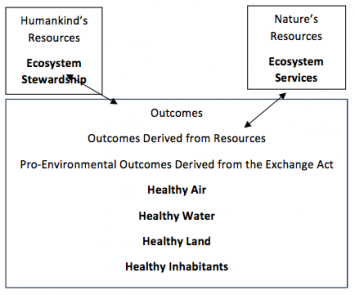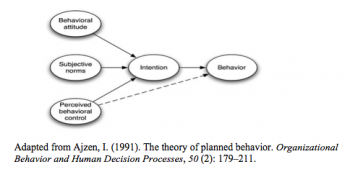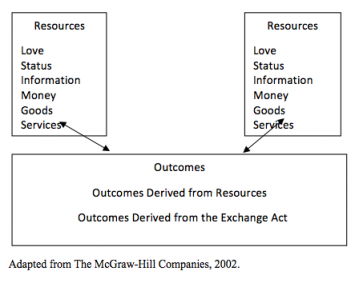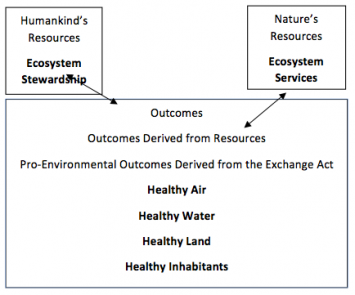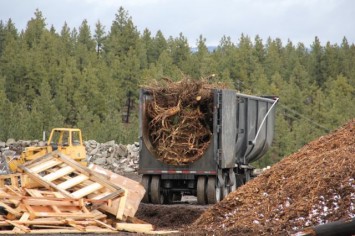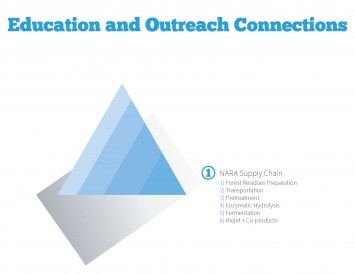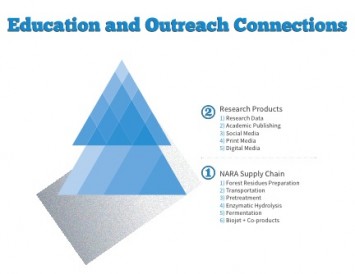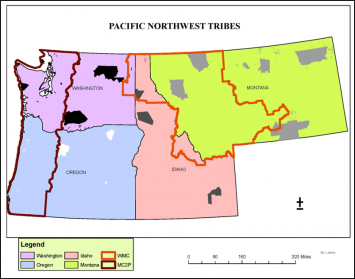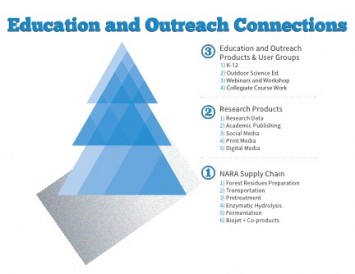FEBRUARY 20TH, 2017
For further details log on website:
http://www.jsedimensions.org/wordpress/content/reframing-humankinds-relationship-with-nature-contributions-from-social-exchange-theory_2017_02/
Abstract: In this paper we compare and contrast the Theory of Planned Behavior (Ajzen, 1985) with Social Exchange Theory (Homans, 1958) as conceptual foundations for eliciting pro-environmental behavior. We reason that Social Exchange Theory provides the better orientation because of its metaphorical power in casting humankind as being in a reciprocal relationship with nature rather than being in a superior position over nature. We illustrate our thinking by discussing ecosystem services (Melillo & Sala, 2008) as nature’s contribution to humankind in return for humankind’s responsible environmental stewardship.
Keywords: biodiversity, ecosystem services, humankind, nature, pro-environmental behavior, Social Exchange Theory, Theory of Planned Behavior
The diminishment of the Earth’s biodiversity due to human impacts is occurring at an alarming rate (Cardinale, et al., 2012; Pereira, Navarro, & Martins, 2012; Perrings et al., 2011) despite concerted efforts to change human beliefs, attitudes, and behaviors toward nature. This is a particularly vexing problem in the Western industrialized world where humans often see ourselves as being separate from and having dominion over nature (Annan, 2008; Schramski, Gattie, & Brown, 2015; Vitousek, Mooney, Lubchenco, & Melillo, 1997; White, 1967). Nature tends to be viewed as an object ‘out there’ that derives value to the extent it serves our purposes. This highly anthropocentric orientation to humankind’s relationship with nature leads to one-way exchanges; humans acting toward nature rather than with nature.
The purpose of our paper is to discuss Social Exchange Theory (SET) as an alternative conceptual orientation to humankind’s relationship with nature, thereby offering a different approach to changing human beliefs, attitudes, and behaviors. We make our case by first reviewing the strengths and weaknesses of the Theory of Planned Behavior (TPB), a common starting point for eliciting pro-environmental behavior. We then address SET’s potential to supplant the TPB as a preferable starting point for eliciting pro-environmental behavior by shifting the focus from doing things to nature to doing things with nature. We conclude the discussion by reaffirming the need to reframe humankind’s relationship with nature to stem the loss of biodiversity and protect and preserve the health and well-being of the planet’s inhabitants, human and non-human alike.
Eliciting Pro-Environmental Behavior
However daunting the challenge of trying to change human beliefs, attitudes, and behaviors in ways that will protect and preserve the Earth’s rapidly diminishing biodiversity, it is a challenge that must be met. The change sought after is often described as eliciting pro-environmental behavior, or “that which harms the environment as little as possible, or even benefits the environment” (Steg & Vlek, 2009). How best to elicit pro-environmental behavior is a topic of ongoing concern and debate.
Theory of Planned Behavior
Many interventions designed to elicit pro-environmental behavior begin with Ajzen’s TPB (1991). In general, the TPB seeks to explain how people form behavioral intentions that lead to certain actions (See Figure 1). The TPB posits that if an intervention can impact the formation of a behavioral
intention, a change in action should follow that corresponds to the desired intention. Behavioral intentions are formed based on one’s beliefs and attitudes toward the behavior, social norms about the behavior, and perceived behavioral control to carry out the behavior.
Many researchers have attempted to apply the logic of the TPB in eliciting pro-environmental behavior, with varying degrees of success. In one meta-analysis, researchers found that of 57 studies looking at ‘psychological action models’ to affect behavior change, the majority sought to impact behavior by first changing behavioral intentions (Bamberg & Moser, 2006). Other researchers have found that many interventions based on the TPB analyze the costs and benefits of actions and the role of social norms and personal morals in accounting for changes in behavioral intentions (Steg & Vlek, 2009). They note as well that many interventions use informational strategies that attempt to change perceptions or increase knowledge in order to persuade, alter motivations, or address social norms related to the person’s attitude toward the environment. In sum, the TPB has served as a popular starting point for eliciting pro-environmental behavior. Interventions stemming from the TPB are intended to change behavior in a manner that results in less damage (or more good) being done to the environment. This approach asks people to modify their actions in deference to their impact on nature, recognizing that beliefs, attitudes, and behaviors result in certain kinds of predictable actions toward nature.
However popular the TPB may be as a foundation for eliciting pro-environmental behavior, it is also wanting in certain respects. For example, the TPB suggests a linear route to human behavior change based on individual beliefs, attitudes, and one’s interpretation or value of social norms. It positions the individual as the agent of change, with motivation or support coming from social, attitudinal, or structural components. The individual generates behavior and directs his or her behavior toward the desired action. The model is largely unidirectional.
Focusing on human-centered intentionality is especially problematic when trying to change behaviors that affect nature adversely, because it is often difficult to see how any one individual’s behavioral change can have a positive effect on either a personal or societal level. This ‘vision’ problem has been discussed as a principal obstacle to eliciting pro-environmental behavior for decades (Dustin, Schwab, & Bricker, 2010; Tilden, 1975). If people cannot see how a particular behavioral change will improve the quality of their lives, there is little motivation for them to behave in the desired manner. Within the context of the TPB, this accounts for the integral role that ‘perceived behavioral control’ plays on motivation to form a behavioral intention (Madden, Ellen, & Ajzen, 1992). People need to believe that a change in their behavior will contribute to, or result in, desirable outcomes; otherwise, they will not likely form the desired intention leading to the desired behavior. Thus, even though actions that are environmentally friendly often carry a positive normative belief, perceived behavioral control may be constrained by the belief that one’s behavior will not have any significant impact.
This limitation of the TPB is exacerbated by its neglect of emotional variables such as threat, fear, compassion, connectedness, or other feelings that may influence the formation of behavioral beliefs, attitudes, intentions, and behaviors (Koger & Winter, 2010; Stern, 2005). Environmental controversies are often fraught with deep emotional feelings that influence how individuals respond to calls for changing human behaviors toward nature. Once again, if what is being asked for in the way of behavioral change does not resonate with the experience of people and engage them in an emotional way, the likelihood of eliciting the desired behavioral change is lessened. In the absence of a feeling of reciprocity, environmental issues are thus more inclined to be deemed distant and abstract, especially if the temporal or spatial impacts of the behavior in question are far removed from people’s daily lives. This is why Tilden (1975) stressed the importance of interpretive messages resonating with the experience of people receiving the messages. Otherwise, the messages come across as sterile and unappealing.
The TPB thus tends toward a one-way approach to behavioral change that seeks to address why and what humans do to achieve a desired end, and offers a way to change that one-way behavior. The absence of a feeling of reciprocity in the theory and its neglect of emotional variables that tend to influence environmental commitment and decision-making weaken its usefulness as a starting point for eliciting pro-environmental behavior. The TPB leads to interventions that do something to, or act in a certain way toward, but never with, the other entity impacted by the behavior—nature.
Social Exchange Theory
A potentially more useful approach to understanding, predicting, and changing attitudes and behaviors regarding nature is provided by Social Exchange Theory [SET] (Homans, 1961). This theory is often used to explain human interactions, particularly those in which people seek to gain something from the relationship. The theory outlines how relationships must be beneficial and reciprocal in order to work and be sustainable.
SET was conceived as a way to help broadly explain and predict how individuals and social groups interact with one another when exchanging goods or services (Homans, 1958). The theory assumes humans are rational beings who seek to meet their basic needs (see Figure 2).
When making exchanges, SET suggests there are always costs and benefits that both sides must consider, and that behavioral exchange will be driven by the extent to which each side determines the benefits (or payoff) of the exchange are greater than the exchange’s costs. The benefits that someone receives from the exchange constitute the reward for their choice and participation in the exchange and serve to reinforce the behavior enacted in the exchange (Homans, 1961). Typically, the exchange provides benefits to, or has some value to, both parties, thereby mutually reinforcing the exchange and its continuation over time.
Homans (1958) offered several propositions in developing SET that have important implications for its usefulness as a starting point for eliciting pro-environmental behavior. First, he posited that behavior that offers positive rewards or consequences will be repeated. Second, he posited that behaviors that are rewarded (or reinforced) will be repeated under the same or similar circumstances. Third, he posited that the more valuable the result of a behavior is to an actor, the more likely that behavior is to be performed. Fourth, he posited that the more often an actor receives a reward for a behavior, the less valuable will be receiving any more of that reward. Finally, he posited that an actor will be angry or aggressive if he or she does not receive the reward when it is expected.
Extending and clarifying SET, Blau (1986) adds that a social exchange, as opposed to an economic exchange, includes some level of ambiguity as to exactly what goods and services might be exchanged. One person may do another a favor, with only a general expectation that some unspecified favor will be returned in the future. Further, he stipulates that favors being exchanged “can only be achieved through interactions with other persons, and it [the actor] must seek to adapt means to further achievement of these ends” (Blau, 1986, p. 5). In other words, each exchange should help give rise to the next. Moreover, a social exchange is rarely perfectly equal and at some point the exchange gives rise to power differentials in the relationship. This occurs when one person has more goods or is in a better position in society (or the network) than the other, rendering ‘the other’ dependent on the first for goods and services (Cook & Rice, 2006).
Underlying Assumptions
Before discussing the applicability of SET as a foundation upon which to elicit pro-environmental behavior, it is important to consider the assumptions underlying its potential usefulness. The first, and most obvious assumption is that “humanity, having evolved as part of the web of life, remains enmeshed within it” (Wilson, 2008, p. vii). This view challenges the idea that humankind is separate from and above nature and replaces it with the idea that humankind is a part of nature, and, just as importantly, that biodiversity has a profound influence on human health and well-being (Wilson). This perspective recognizes humankind’s rootedness in, and dependence on, nature for its sustenance. Sustaining life, including human life, is grounded in understanding that life’s processes consist of ongoing exchanges between and among all things living and non-living.
A second assumption that flows from the first is that in a world characterized by ongoing exchanges between and among all things living and non-living there are really no one-way exchanges. Feedback, however subtle, is continuous whether we humans see it, listen to it, taste it, touch it, or smell it. Our species’ challenge is to use all of our senses to be increasingly aware of the feedback and make adjustments in our conduct accordingly. This requires openness to new learning and accepting both emotionally and intellectually that change may be required in the way we humans conduct ourselves, however accustomed to, or comfortable with, traditional patterns of behavior.
A third assumption acknowledges that even though SET starts by assuming all actors are rational humans, we know that emotions play into human decision-making. Meanwhile, nature is neither emotional nor rational. However, nature is– without human or other interference – generally predictable with repeating patterns of behavior. This makes the idea of exchanges reliable as we humans increasingly have a good idea of what to expect from nature.
A fourth and final assumption is that while nature does not communicate its needs and wants in a language familiar to humankind, it does ‘communicate’ in a variety of ways that we humans have the capacity to interpret accurately. Conceiving of humankind as nature’s invention for keeping track of itself (Oelschlaeger, 1991), we humans have a moral responsibility to act on nature’s behalf in ways that correspond to pro-environmental behavior (Stone, 1974). Increasingly, lessons learned from scientific inquiry inform our species’ thinking in ways that could and should result in better environmental decision-making.
The Relevance of Social Exchange Theory
Perhaps the best example of the potential usefulness of SET as a point of departure for eliciting pro-environmental behavior is the concept of “ecosystem services” (Daily, 1997; National Research Council, 2004). Ecosystem services refer to the “various ways that organisms, and the sum total of their interactions with each other and with the environments in which they live, function to keep all life on this planet, including human life, alive” (Chivian & Bernstein, 2008, p. xi). Melillo and Sala (2008) divide ecosystem services into four major categories: provisioning, regulating, cultural, and supporting services. Provisioning services are products the ecosystem provides humans (food, fuel, fiber, medicines, etc.) Regulating services refer to the benefits obtained from environmental regulation of ecosystem processes (cleaning air, purifying water, mitigating floods, controlling erosion, detoxifying soils, modifying climate, etc.). Cultural services refer to nonmaterial benefits obtained from ecosystems (aesthetics, intellectual stimulation, a sense of place, etc.). Supporting services are those services necessary for the production of all other ecosystem services (primary productivity, nutrient recycling, pollination, etc.) These four categories of services represent what we humans gain in exchanges with a healthy (biodiverse) ecosystem.
What can and should the ecosystem expect to gain in return from us for having held up its end of the bargain (as if the ecosystem had the ability to expect anything)? The answer would have to be responsible environmental stewardship from the only self-aware (Schumacher, 1977) member of Leopold’s (1949) land community—humankind (see Figure 3).
SET thus offers an orientation to pro-environmental behavior that is rooted in an ecological worldview (Dustin, Bricker, & Schwab, 2010). It is a perspective that sees the health and well-being of life on Earth stemming from a mutually supportive relationship that honors what the ecosystem can provide humankind and what humankind can provide the ecosystem.
We recognize that the idea that humans can and should live in a mutually supportive relationship with nature has existed for centuries, but it has been largely lost to modern ways of thinking. Many indigenous cultures hold a relational belief system, in which they view themselves as situated within the natural world and connected through interactions with nature and each other (Datta, 2015; Reddekop, 2014). This relational view sees all life, including plants, animals, and water, as animate and “full of thought, desire, contemplation and will,” (Watts, 2013, p. 23). All life forms are thus thought to have agency and can communicate how they should be arranged and treated. Indigenous peoples also believe their ancestors’ spirits are part of the land, so human life is embedded within as well as upon the earth. In such a “non-entity-centric” belief structure there is no ‘I,’ no atomistic view of the world, nor is there a reductionistic logic to understand and control the natural world. From this relational perspective, empathy, respect and reciprocity are inherently part of living relationships (Reddekop, 2014), and indigenous peoples treat the natural world as a close friend with mutual respect and reciprocity. The modern world, in sum, could learn much from indigenous cultures about doing things ‘with’ rather than ‘to’ nature.
Applying Social Exchange Theory to Elicit Pro-Environmental Behavior
The scientific community’s challenge is to translate increased understanding of the workings of the world to the citizenry in a way that engages and inspires them to modify their behaviors as necessary to protect and preserve the sustainability of life on Earth. That brings us back to the question of how best to elicit those behaviors, and it requires revisiting Homans’s five propositions underpinning SET:
- behavior that offers positive rewards or consequences will be repeated
- behaviors that are rewarded (or reinforced) will be repeated under the same or similar circumstances
- the more valuable the result of a behavior is to an actor, the more likely that behavior is to be performed
- the more often an actor receives a reward, the less valuable will be receiving any more of that reward
- actors will be angry or aggressive if they do not receive the reward when they expect it
Rewards (ecosystem services) come readily from Earth’s resources, and that easy and frequent receipt of rewards often leads people to undervalue them (i.e., take them for granted). The challenge is to help people better appreciate the exchange process so they will begin to value the rewards more. Considered together, these conclusions highlight the significance of the aforementioned ‘vision’ problem as well as Tilden’s (1975) admonition that for messages to be effective they must resonate with something in the individual’s experience. What this means in the context of ecosystem services is that we must communicate the rewards associated with those services for humankind in a manner that is understandable, relatable, and meaningful. The difficulty of accomplishing this is heightened by what Hardin (1968) and others have characterized as humankind’s selfish or myopic nature. This, in turn, underscores the importance of communicating how ecosystem services benefit humankind in a way that will not be possible with a reduction in biodiversity and a corresponding deterioration in environmental health.
Adding to the challenge’s complexity is what Blau (1986) described as power differentials in the relationship between the exchanging entities. At first glance, it would appear that nature has many resources upon which humans depend, thus placing power in nature’s hands. However, humans have an abundance of physical and intellectual resources available, and are always ready to employ those resources to maximize profits and minimize costs in social exchanges with nature. This unequal exchange asks much of nature with little or no gain to nature in the process. Understood this way, humans are no longer in a social exchange with nature. Rather, they are involved in a one-way process of taking goods and services, without allowing nature to accrue any benefits in the process. In SET, this has been explained as the relative use of power that results in an unequal distribution of rewards across positions in a social network (Cook & Rice, 2006). Left unchecked, while it may appear that humans are in a favorable position relative to nature in receiving rewards rather than giving them, in time nature may no longer have resources to give and stop participating in the exchange. If, however, we humans were to come to our senses and recognize our dependence on nature for ecosystem services, and recognize as well that nature ultimately holds the power in the relationship, and that even with human innovation and technological advances we cannot adequately replicate nature’s complex systems, then we humans might be persuaded to engage in a more equitable social exchange with nature–a mutually beneficial, reciprocal exchange in which power, costs, and benefits are balanced, and both sides receive something from the relationship.
Conclusion
In closing, it is important to emphasize language’s metaphorical power in helping change the way we might think about our relationship with nature. Leopold’s (1949) land ethic ushered in the possibility of we human beings stepping down from our anthropocentric pedestal to assume a more humble station among life’s creations when he implored us to see ourselves as plain members and citizens of the larger community of life. In the years since, others have pointed out that the language we speak both reflects and shapes the way we see ourselves in relation to the larger living world (Cachelin, Norvell, & Darling, 2010; Cachelin, Rose, Dustin, & Shooter, 2011; Cachelin & Ruddell, 2013). To distance ourselves from nature through our spoken language, and to consider nature as an ‘other’ that is ‘out there’ serving as a mere backdrop for our human drama, is not helpful. It reinforces the idea of a one-way relationship between humankind and nature, when ecology teaches that it has been, is, and always will be a two-way relationship. Consequently, we believe supplanting the Theory of Planned Behavior with Social Exchange Theory as a conceptual foundation upon which to build a healthier and more sustainable human/nature relationship is a promising metaphorical step in the right direction.
References
Ajzen, I. (1991). The theory of planned behavior. Organizational Behavior and Human Decision Processes, 50(2), 179–211.
Ajzen, I. (1985). From intentions to actions: A theory of planned behavior. In J. Kuhl & J. Beckmann (Eds.), Action control: From cognition to behavior. (pp. 11-39). Berlin, Heidelberg, New York: Springer-Verlag.
Annan, K. (2008). Prologue. In E. Chivian & A. Bernstein (Eds.) Sustaining life: How human health depends on biodiversity. p. ix. New York: Oxford University Press.
Bamberg, S., & Moser, G. (2006). Twenty years after Hines, Hungerford, and Tomera: a new meta-analysis of psycho-social determinants of pro-environmental behavior. Journal of Environmental Psychology, 27(2006), 14-25.
Blau, P. (1986). Exchange and power in social life. New York: Transaction Publishers.
Cachelin, A., Rose, J., Dustin, D., & Shooter, W. (2011). Sustainability in outdoor education: Rethinking root metaphors. Journal of Sustainability Education, 2: March.
Cachelin, A., Norvell, R., & Darling, A. (2010). Language fouls in teaching ecology: Why traditional metaphors undermine conservation literacy. Conservation Biology, 24(3), 669-674.
Cachelin, A., & Ruddell, E. (2013). The impact of language framing on sustainability education. Journal for Environmental Studies and Sciences, 3(3), 306-315.
Cardinale, B.J. (2012) Biodiversity loss and its impact on humanity. Nature 486, 59–67.
Chivian, E., & Bernstein, A. (Eds.) (2008). Sustaining life: How human health depends on biodiversity. New York: Oxford University Press.
Cook, K., & Rice, E. (2006). Social exchange theory. In J. DeLamater (Ed.) The handbook of social psychology. pp. 53-76. New York: Springer.
Daily, G. (Ed.) (1997). Nature’s services: Societal dependence on natural ecosystems. Washington, D.C.: Island Press.
Dustin, D., Bricker, K., & Schwab, K. (2010). People and nature: Toward an ecological model of health promotion. Leisure Sciences, 32(1), 3-14.
Dustin, D., Schwab, K., & Bricker, K. (2010). Thermus aquaticus and you: Biodiversity, human health, and the interpretive challenge. Rural Connections, September: 47-50.
Hardin, G. (1968). The tragedy of the commons. Science, 162 (3859), 1243-1248.
Homans, G. (1961). Social behavior: Its elementary forms. New York: Harcourt, Brace, & World, Inc.
Homans, G. (1958). Social behavior as exchange. American Journal of Sociology, 63 (6) 597-606.
Koger, S., & Winter, D. (2010). The psychology of environmental problems. New York: Psychology Press.
Leopold, A. (1949). A sand county almanac. New York: Oxford University Press.
Madden, T.J., Ellen, P.S., & Ajzen, I. (1992). A comparison of the theory of planned behavior and the theory of reasoned action. Personality and Social Psychology Bulletin, 18(1), 3-9.
Melillo, J., & Sala, O. (2008). Ecosystem services. In E. Chivian & A. Bernstein (Eds.) Sustaining life: How human health depends on biodiversity. pp. 75-115. New York: Oxford University Press.
National Research Council, (2004). Valuing ecosystem services: Toward better environmental decision-making. Washington, D.C.: National Academies Press.
Oelschlaeger, M. (1991) The idea of wilderness: From prehistory to the age of ecology. New Haven: Yale University Press.
Pereira, H., Navarro, L., & Martins, I. (2012). Global biodiversity change: The good, the bad, and the unknown. The Annual Review of Environment and Resources, 37, 25-50.
Perrings, C., Naeem, S., Ahrestani, F.S., Bunker, D.E., Burkill, P., Canziani, G., … Weisser, W. (2011). Ecosystem services, targets, and indicators for the conservation and sustainable use of biodiversity. Front. Ecol. Environ, 9, 512–520.
Schramski, J.R., Gattie, D.K., Brown, J.H. (2015). Human dominiation of the biosphere: Rapid discharge of the earth-space battery foretells the future of humankind. Proceedings of the National Academy of Sciencs of the United States of America. 112(31).
Schumacher, E. (1977). A guide for the perplexed. New York: Harper & Row.
Steg, L., & Vlek, C. (2009). Encouraging pro-environmental behaviour: An integrative review and research agenda. Journal of Environmental Psychology, 29, 309-317.
Stern, P. (2005). Understanding individuals’ environmentally significant behavior. Environmental Law Reporter: News and Analysis, 35: 10785–10790.
Stone, C. (1974). Should trees have standing? Law, morality, and the environment. New York: Oxford University Press.
Tilden, F. (1975). Interpreting our heritage. Chapel Hill, NC: University of North Carolina Press.
Vitousek, P., Mooney, H., Lubchenco, J., & Melillo, J. (1997). Human domination of earth’s ecosystems. Science, 227 (5325), 494-499.
White, L. (1967). The historical roots of our ecological crisis. Science, 155 (3767), 1203-1207.
Wilson, E. (2008). Foreword. In E. Chivian & A. Bernstein (Eds.) Sustaining life: How human health depends on biodiversity. p. vii. New York: Oxford University Press.
For further details log on website:
http://www.jsedimensions.org/wordpress/content/reframing-humankinds-relationship-with-nature-contributions-from-social-exchange-theory_2017_02/
